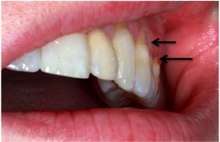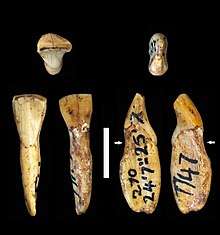Non-carious cervical lesions
Non-carious cervical lesions (NCCLs) are defined as dental tissue lost at or near the cementoenamel junction (CEJ), and not relating to tooth decay.[1] NCCLs are common in the dentitions of recent human populations.[2] They may result from several processes including abrasion, acid erosion and abfraction.[3] It is thought recent changes in diet and behaviour may explain the high rate of NCCLs in humans today, including consuming a lot of acidic foods and drinks, as well as tooth brushing techniques. Periodontal disease is often also a contributing factor.


Archaeological non-carious cervical lesions
When NCCLs are present in archaeological samples they can provide insight into behaviour and diet.[4] Abrasion is the most common mechanism of NCCLs observed in archaeological samples, and results from non-masticatory contact of an object with teeth, often through cultural or therapeutic behaviour.[5] Most NCCLs in archaeological examples are attributed to abrasion, with ‘toothpick grooves’ particularly common.[5] Less commonly acid erosion can cause NCCLs, and is caused by the chemical dissolution of dental tissues by acids of non-bacterial origin, most commonly low pH diets. Abfraction, is almost never seen in the pre-modern samples, leading some researchers to suggest it is a uniquely modern issue caused by recent dietary and behavioural changes.
References
- Towle, Ian; Irish, Joel D.; Elliott, Marina; De Groote, Isabelle (2018-09-01). "Root grooves on two adjacent anterior teeth of Australopithecus africanus". International Journal of Paleopathology. 22: 163–167. doi:10.1016/j.ijpp.2018.02.004. ISSN 1879-9817. PMID 30126662.
- Venkatesan. "Critical review of noncarious cervical lesions". www.srmjrds.in. Retrieved 2019-01-10.
- Michael, J. A.; Townsend, G. C.; Greenwood, L. F.; Kaidonis, J. A. (2009). "Abfraction: separating fact from fiction". Australian Dental Journal. 54 (1): 2–8. doi:10.1111/j.1834-7819.2008.01080.x. ISSN 1834-7819. PMID 19228125.
- "Root grooves on two adjacent anterior teeth of Australopithecus africanus". ResearchGate. Retrieved 2019-01-10.
- Estalrrich, Almudena; Alarcón, José Antonio; Rosas, Antonio (2017). "Evidence of toothpick groove formation in Neandertal anterior and posterior teeth". American Journal of Physical Anthropology. 162 (4): 747–756. doi:10.1002/ajpa.23166. hdl:10261/159768. ISSN 1096-8644. PMID 28035661.